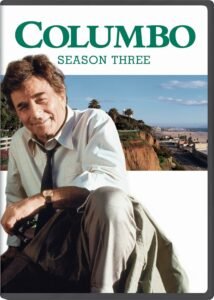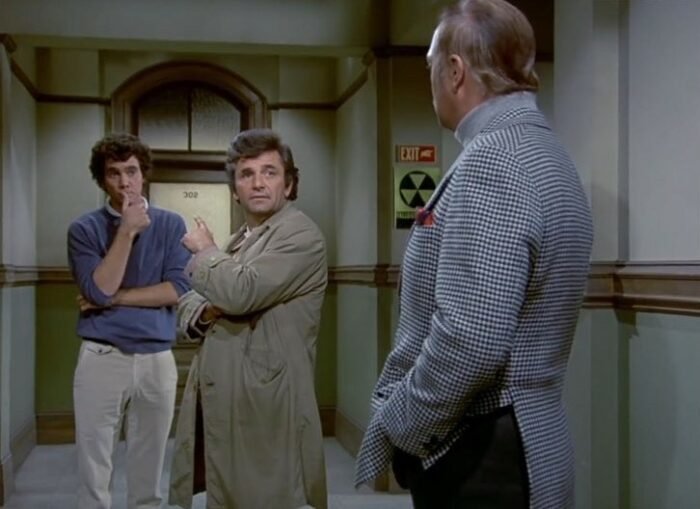Plagiarism in Pop Culture: Columbo (Part 1)

When it comes to plagiarism being featured as a plot point, there’s no genre that is quite as prolific as the murder mystery/police procedural genre.
As we’ve discussed here, Death in Paradise has done it twice, as has Law & Order: Criminal Intent and even the Sherlock-themed show Elementary has done it once.
If you’re writing a story and either need a reason for a murder to take place or for a murderer to get caught, plagiarism has always been a popular go to.
However, it’s not just recent stories that have used plagiarism in this way. The popular detective series Columbo featured back-to-back episodes that used plagiarism as a key element of the plot.
The show, which actually is a series of movies, originally aired for 43 episodes over seven seasons between 1971 and 1978. After its initial run, the show lived on for several more decades with additional films, books and other media, which were released irregularly.
However, the two episodes we’ll be looking at are both from season three of the original run. The first, which we are looking at today, is entitled Publish or Perish and was the fifth episode of the season.
But while the story is definitely an interesting examination of how plagiarism is featured in popular culture, it’s also unique in that the plagiarism only comes up at the very end of the story and, most importantly, is fake.
As such, it’s a challenging episode to examine, but one well worth taking a more in-depth look at.
The Plot

The episode focuses on three characters (other than Columbo). The first is Riley Greenleaf, a publisher who is on the outs with bestselling author, Alan Mallory, and Greenleaf’s hired hitman, Eddie Kane.
The episode begins with Kane, who is an explosives enthusiast, throwing homemade bombs at cars at a junkyard. He’s approached by Greenleaf, who outlines the plan to murder Mallory that night.
As we learn later, Mallory’s contract with Greenleaf is expiring, and he’s taking his bestselling track record to a competitor. As such, Greenleaf instructs Kane to murder Mallory at 10:30 that night, with a single bullet using Greenleaf’s gun and being careful to leave Greenleaf’s fingerprint behind. In exchange, Greenleaf agrees to publish Kane’s book about explosives.
While Mallory was performing the murder, Greenleaf went off on what can be described as a drunken rampage. First, he gets himself thrown out of a bar and then has a deliberate car accident in the parking lot. After that confrontation, he parks his car illegally and is eventually arrested for public intoxication.

Greenleaf’s plan to both implicate and exonerate himself went as expected. Initially, all the physical evidence pointed to him, and he even feigned belief that he had killed Mallory while blacked out. However, when news of the accident and the incident at the bar reached Columbo and the rest of the police, it seemed as if the heat had been thrown off him.
For a time, the focus was on trying to find who could have killed Mallory and try to frame Greenleaf. We learn that Mallory was writing the last in a line of bestselling books, which he was dictating and having others type of up the pages. We also learned that he had been paid a large sum of money to not kill off the main character, leaving open the possibility of future books.
But despite the misdirection, inconsistencies and issues with Greenleaf’s story, along with additional evidence, kept the focus on him. This prompted him to plan his second murder.
He met with Kane under the guise of celebrating their victory, but instead spiked his champagne, rendering him unconscious. He then typed up a book outline, backdated it to 9 months prior and made two copies, one he kept for himself and the other he left there. He then detonated one of Kane’s devices, attempting to make it look like Kane had died in an accidental explosion.
Confronted again by Columbo, Greenleaf “confesses” that Kane had sent him the outline months prior and, though he didn’t think Kane could write the story, he passed on the outline to Mallory who plagiarized it. He then postulated that Kane killed Mallory and framed him in revenge.

However, this final story fell apart quickly. Columbo, talking with Mallory’s cohorts, showed that the ending Kane allegedly wrote nine months ago was only written a few weeks prior, due to the request. As such, there’s no way Kane’s purported outline was authentic.
Combine this with a confession from the courier that provided Greenleaf with copies of Mallory’s dictation, and Columbo had his man.
Understanding the Plagiarism
The story is unique for two reasons:
- The Plagiarism Didn’t Happen: Greenleaf is trying to set up a plagiarism scandal as a motive for murder to throw suspicion off himself, not plagiarism actually took place.
- It’s Only at the Very End: All the discussion of plagiarism takes place in the last third of the movie. Its introduction is abrupt and, ultimately, very brief. That said, it’s still crucial to the plot, in particular how the murders were solved.
As such, the easiest way to examine the plagiarism is as if it were real.
To that end, the alleged plagiarism is fairly straightforward. An unknown author sends in an outline, possibly of a fan fiction, to a publisher. That publisher then decides to take that idea and then give it to a better-known author for them to write, depriving the smaller author of credit and royalties.
This is a common fear and not one limited to the publishing industry. We routinely see accusations along these lines in the world of music, filmmaking and art. The idea that the famous creator plagiarizes a relative unknown and uses their clout to get away with it.
However, most of such allegations end up being like this one: False. Though most people who make such accusations usually aren’t knowingly making false claims (especially not to cover up a murder), such cases of plagiarism are actually fairly rare.
Most, ultimately, are just non-protectable similarities, coincidences or misinterpretations of the situation.
However, it’s a narrative that has still entered the public consciousness, likely in part due to its repeated inclusion in popular culture, so it makes sense that Greenleaf, who would have been very familiar with it, would jump on it.
Unfortunately, the ending is where the narrative falls apart for me. The big break for Columbo was that Kane’s supposed outline ended with the main character going to a monastery rather than being killed off. According to Columbo, there was no way Kane could have come up with that ending, as it was only necessitated by an agreement from a few weeks prior.
But the idea is not so unique or original that there’s no way Kane, or someone else, couldn’t have thought of it beforehand. It’s virtually a trope unto itself. To me, the much more suspicious thing is how similar the two outlines were overall. One would think that, if Mallory did plagiarize, he would only take certain ideas or notions, not the whole thing.
While it would have muddied the plagiarism waters, it would have been much more realistic and believable to me, better fitting how plagiarists actually work. However, that extreme similarity is one of the reasons Columbo critically analyzes the outline, realizing the aforementioned issue.
As such, the episode is ultimately a fairly good portrayal of plagiarism in popular culture. It presents a fake but plausible-sounding plagiarism narrative that is debunked appropriately by a clever detective who simply analyzed the work in a critical light.
It’s a decent plagiarism-related story, even if plagiarism isn’t the focus of most of the tale.
Bottom Line
Though plagiarism is important in this story and the episode does outline a full plagiarism narrative, it’s neither the most important part of the story nor the focus of the episode.
However, in many ways, that makes this episode more important than shows like Arthur or Boy Meets World. We get to see what the writers of Columbo say about plagiarism when they aren’t talking about plagiarism directly.
Overall, the answer is positive. Though the plagiarism narrative is largely unrealistic and deeply flawed, it’s a fake narrative created by the story’s villain. Even in-universe, the narrative is false and is debunked by the detective.
So, while it may not be the most plagiarism-heavy example of plagiarism in pop culture, it is still relatively well done and that tells an interesting story around a relatively realistic story of plagiarism.
All in all, not a bad example of the trope in use.
More Plagiarism in Pop Culture (In Reverse Order)
Want more Plagiarism in Pop Culture? There Are 40 others to check out!
- Ferris Bueller
- Randy Feltface
- Bob’s Burgers
- Columbo (Part 2)
- Columbo (Part 1)
- Death in Paradise (Part 2)
- American Auto
- Saturday Night Live
- The Conners
- Death in Paradise (Part 1)
- Lobachevsky
- Back to School
- The Golden Girls
- Young Sheldon
- The Goldbergs (Part 2)
- King of the Hill (Part 2)
- Yesterday
- King of the Hill (Part 1)
- The Kids Are Alright
- Big Fat Liar
- Coco
- Re-Animator
- Elementary
- Instinct
- Fresh Off the Boat
- The Goldbergs (Part 1)
- Lou Grant
- Star Trek: The Original Series
- Arthur
- Criminal Minds
- Mystery Science Theater 3000
- Cheers
- WKRP in Cincinnati
- Boy Meets World
- Law & Order: Criminal Intent (Part 2)
- Law & Order: Criminal Intent (Part 1)
- Jane the Virgin
- The Waltons
- Leave it to Beaver
- The Facts of Life
Want to Reuse or Republish this Content?
If you want to feature this article in your site, classroom or elsewhere, just let us know! We usually grant permission within 24 hours.
